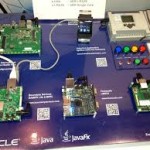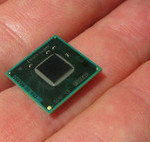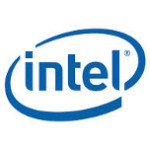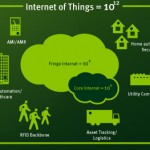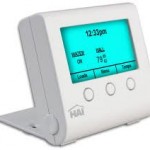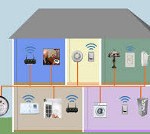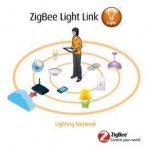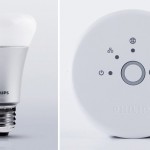Freescale Semiconductor and Oracle announced earlier this year that they are working together to develop the “OneBox”, a gateway platform for secured service delivery for Internet-of-Things applications based on open Java technology and Freescale silicon.
So what is OneBox all about? The aim of OneBox is standardising and consolidating the delivery and management of Internet-of-Things services through one gateway box rather than multiple gateway boxes from different vendors.
The idea is that the gateway appliance and its Java-based software stack can “speak” all of the different protocols being used to connect devices to the network in a context of, say, a home automation application – a single gateway that is interoperable with every networked Internet-of-Things device in the home.
For example, the OneBox gateway will have the ability to connect to multiple different kinds of RF networks such as 802.15.4, 802.11, Bluetooth and Bluetooth Low Energy, providing conversion and interoperability between different connectivity standards.
The “smart home” OneBox reference implementation from Freescale runs Java SE Embedded and is powered by a Freescale i.MX 6 series applications processor built on the ARM Cortex-A9 core. OneBox has enough local processing power to handle some real-time data processing, and can then send the processed data up to the cloud if desired.
There, Oracle’s infrastructure will be happy to crunch those bytes for you although you could use whatever cloud infrastructure you’d like – there is no lock-in. This local processing power is advantageous because it improves responsive interaction by removing the latency of a trip out to the remote server – for example, when you push the button to turn your lights on you want an effectively immediate response, not a delay of many seconds before the lights actually turn on.
The entire secured service delivery infrastructure – from the core of the network through the gateway to the small edge nodes – uses Java technology, pitched by Oracle as a unifying, open platform for the Internet of Things.
The Freescale/Oracle development team used Java SE embedded on the gateway box and Java ME embedded for the microcontrollers in their OneBox reference implementation. With its broad adoption, open source model, huge ecosystem and well-defined roadmap, Java technology is being pitched by Oracle and Freescale as ideally suited for Internet-of-Things requirements.
Due to the Java base, the system will be open throughout, without requiring hoops for programmers or device developers to jump through. OneBox offers a secure, standard and open infrastructure model for the delivery of Internet-of-Things services, combining end-to-end software with a converged gateway design to aim to establish a common, open framework for secured Internet-of-Things service delivery and management from the core of the network right through to low-power wireless sensors and other nodes at the edge of the network.
As part of the collaboration, Freescale will join the Java Community Process and work with Oracle and other JCP members to drive development of technical specifications for Java, particularly focusing on Java on resource-constrained platforms such as the low-cost microcontrollers that provide the embedded intelligence in Internet-of-Things enabled products.
Freescale will also work with Oracle and other JCP members on new and enhanced Java APIs to improve the support for Internet-of-Things protocols and features available on their microcontroller hardware.
The addition of a service layer based on enterprise-grade Java as an open standard, along with full security, on top of the whole system including the smallest resource-constrained microcontrollers takes the OneBox platform beyond a typical converged gateway.
Oracle and Freescale see it as a blueprint for an ideal secured service delivery infrastructure for the Internet of Things, one that will solve some of the common problems perceived as limiting the advancement of the Internet of Things.
OneBox is designed, both in terms of hardware and software, to be very modular, so the appropriate connectivity – ethernet, WiFi, 802.15.4/6LoWPAN, ANT, Bluetooth, whatever – can be “plugged in” and the corresponding software blocks needed for a particular service automatically loaded. This modularity supports future standards and a variety of use cases – from home automation and consumer electronics to industrial automation.
Freescale believes that it’s the small players that will bring the majority of innovation to the table, and they have specifically ensured that the OneBox platform is open and based on readily available software and hardware in order to promote participation by smaller players and decrease barriers to entry.
Freescale’s edge node sensors and devices based on Kinetis ARM microcontrollers are cheaply available, with all of the tools needed. Freescale silicon is distributed openly through small-volume distributors, datasheets and documentation for their processors are openly available to all, and Java is openly available to download and license.
After this quick summary it appears that this new idea between Freescale and Oracle could provide the backbone for a new, open-source and easily-adapable Internet-of-things platform for almost any situation. As the technology proceeds to mature we’d be more than happy to examine the possibilies available with your organisation for your benefit.
And we’re ready to offer our experience and know-how on this and every other stage of product development to meet your needs. As we say – “LX can take you from the whiteboard to the white box”. So for a confidential discussion about your ideas and how we can help bring them to life – click here to contact us, or telephone 1800 810 124.
LX is an award-winning electronics design company based in Sydney, Australia. LX services include full turnkey design, electronics, hardware, software and firmware design. LX specialises in embedded systems and wireless technologies design. https://lx-group.com.au
Published by LX Pty Ltd for itself and the LX Group of companies, including LX Design House, LX Solutions and LX Consulting, LX Innovations.


